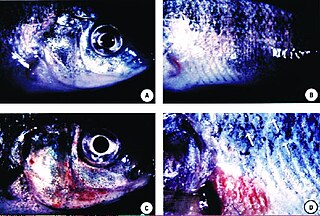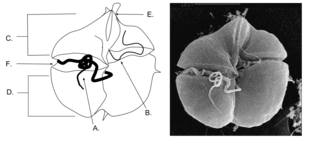Ciguatera fish poisoning (CFP), also known as ciguatera, is a foodborne illness caused by eating reef fish contaminated with ciguatoxins. Such individual fish are said to be ciguatoxic. Symptoms may include diarrhea, vomiting, numbness, itchiness, sensitivity to hot and cold, dizziness, and weakness. The onset of symptoms varies with the amount of toxin eaten. If a lot of toxins are consumed symptoms may appear within half an hour. If a low amount of toxins are consumed symptoms make take a few days to appear. Diarrhea may last up to four days. Symptoms may last a few weeks to a few months. Heart problems such as slow heart rate and low blood pressure may occur.
Ciguatoxins are a class of toxic polycyclic polyethers found in fish that cause ciguatera.

Predatory dinoflagellates are predatory heterotrophic or mixotrophic alveolates that derive some or most of their nutrients from digesting other organisms. About one half of dinoflagellates lack photosynthetic pigments and specialize in consuming other eukaryotic cells, and even photosynthetic forms are often predatory.

Karlodinium is a genus of athecate dinoflagellates that lives worldwide. They are often toxin producing, and compared to the other members of the Kareniaceae, are fairly small at <8-15 µm diameter. They are also able to form intense algal blooms. This species relies of photosynthesis and phagotrphy to grow.
Gonyaulax is a genus of dinoflagellates with the type species Gonyaulax spinifera Diesing. Gonyaulax belongs to red dinoflagellates and commonly causes red tides. It can produce yesotoxins: for example, strains of Gonyaulax spinifera from New Zealand are yessotoxin producers.
Gambierdiscus pacificus is a species of toxic dinoflagellate. It is 67–77 μm long and 60–76 μm wide dorsoventrally and its surface is smooth. It is identified by a four-sided apical pore plate surrounded by 30 round pores. Its first plate occupies 20% of the width of the hypotheca.
Gambierdiscus australes is a species of toxic dinoflagellate. It is 76–93 μm long and 65–85 μm wide dorsoventrally and its surface is smooth. It is identified by a broad ellipsoid apical pore plate surrounded by 31 round pores. Its first plate occupies 30% of the width of the hypotheca.
Gambierdiscus polynesiensis is a species of toxic dinoflagellate. It is 68–85 μm long and 64–75 μm wide dorsoventrally and its surface is smooth. It is identified by a large triangular apical pore plate, a narrow fish-hook opening surrounded by 38 round pores, and a large, broad posterior intercalary plate. Its first plate occupies 60% of the width of the hypotheca.
Gambierdiscus caribaeus is a species of toxic dinoflagellate, which among others causes ciguatera fish poisoning. It is photosynthetic and epibenthic.
Gambierdiscus carolinianus is a species of toxic dinoflagellate, which among others causes ciguatera fish poisoning. It is photosynthetic and epibenthic.
Gambierdiscus carpenteri is a species of toxic dinoflagellate, which among others causes ciguatera fish poisoning. It is photosynthetic and epibenthic.
Gambierdiscus ruetzleri is a species of toxic dinoflagellates, which among others causes ciguatera fish poisoning. It is photosynthetic and epibenthic.

Gambierdiscus is a genus of marine dinoflagellates that produce ciguatoxins, a type of toxin that causes the foodborne illness known as ciguatera. They are usually epiphytic on macroalgae growing on coral reefs.
Gambierol is a marine polycyclic ether toxin which is produced by the dinoflagellate Gambierdiscus toxicus. Gambierol is collected from the sea at the Rangiroa Peninsula in French Polynesia. The toxins are accumulated in fish through the food chain and can therefore cause human intoxication. The symptoms of the toxicity resemble those of ciguatoxins, which are extremely potent neurotoxins that bind to voltage-sensitive sodium channels and alter their function. These ciguatoxins cause ciguatera fish poisoning. Because of the resemblance, there is a possibility that gambierol is also responsible for ciguatera fish poisoning. Because the natural source of gambierol is limited, biological studies are hampered. Therefore, chemical synthesis is required.

Ostreopsis is a genus of free-living dinoflagellates found in marine environments. Some species are benthic; the planktonic species in the genus are known for the toxic algal blooms that they sometimes cause, threatening human and animal health.
Coolia is a marine dinoflagellate genus in the family Ostreopsidaceae. It was first described by Meunier in 1919. There are currently seven identified species distributed globally in tropical and temperate coastal waters. Coolia is a benthic or epiphytic type dinoflagellate: it can be found adhered to sediment or other organisms but it is not limited to these substrates. It can also be found in a freely motile form in the water column. The life cycle of Coolia involves an asexual stage where the cell divides by binary fission and a sexual stage where cysts are produced. Some of the species, for example, Coolia tropicalis and Coolia malayensis, produce toxins that can potentially cause shellfish poisoning in humans.

Cochlodinium is a genus of dinoflagellates belonging to the family Gymnodiniaceae. Over the past two decades, harmful algea blooms (HABs) caused by Cochlodinium had occurred more often and expanded from Southeast Asia to regions such as the rest of Asia, North America and Europe.

Karlodinium veneficum is a species of dinoflagellates belonging to the family Kareniaceae. This species is predominantly inhabiting aquatic environments, particularly in temperate coastal regions.

Kareniaceae is a accepted marine family of relatively small, toxic, unarmored dinoflagellates belonging to the order Gymnodiniales. Species in the Kareniaceae clade often times cause discolored green Harmful algea blooms (HABs) that pose a safety and health risk to humans and the regions around it. Such blooms also pose a risk to coastal aquaculture worldwide, especially places like France, Atlantic ocean, the English channel and the Mediterranean sea.
Ciguatoxin 1 or CTX-1 is a toxic chemical compound, the most common and potent type in the group of ciguatoxins. It is a large molecule consisting of polycyclic polyethers that can be found in certain types of fish in the Pacific Ocean. The compound is produced by Dinoflagellates Gambierdiscus toxicus and is passed on through the food chain by fish. The compound has no effect in fish but is toxic to humans.






